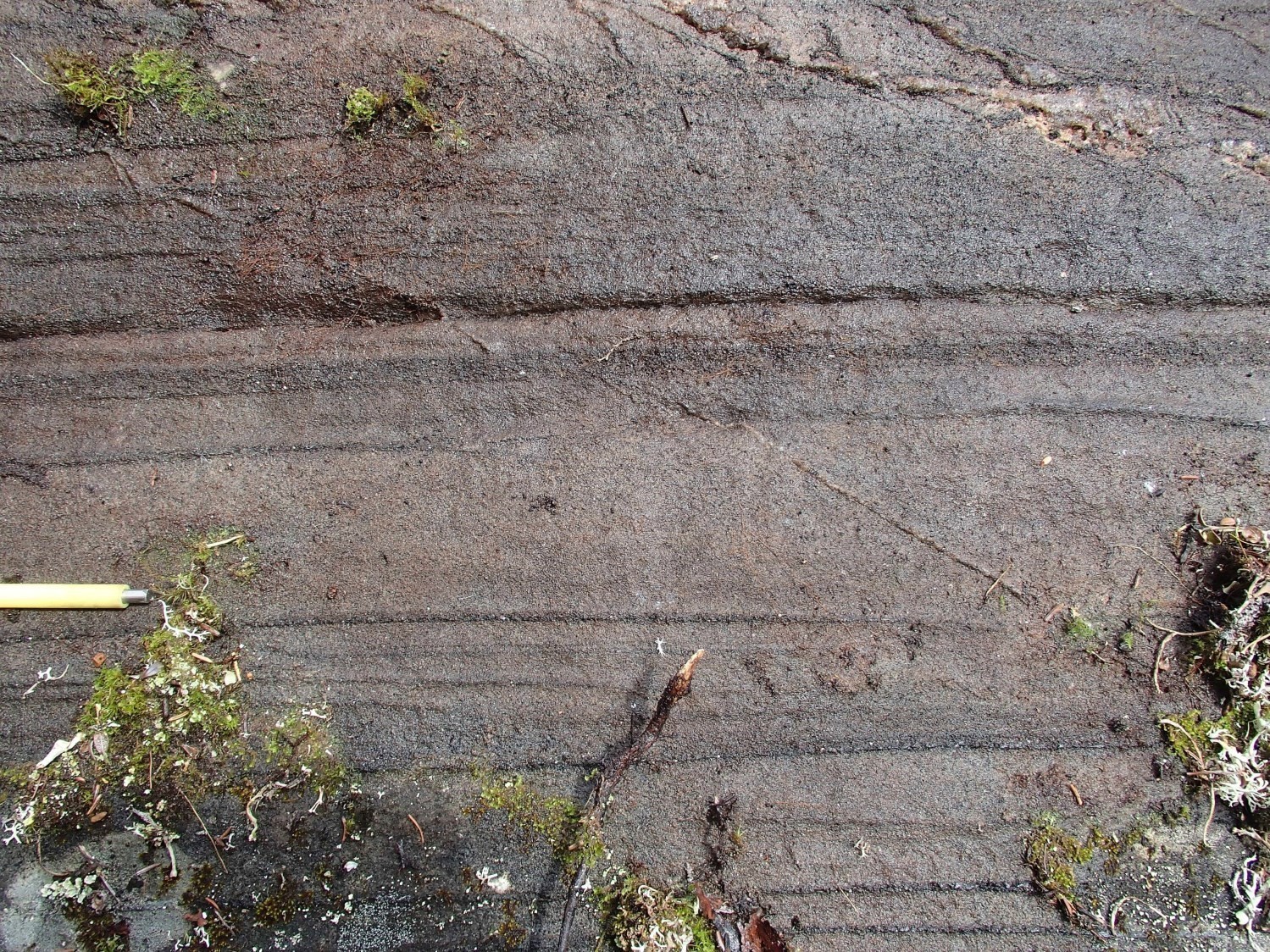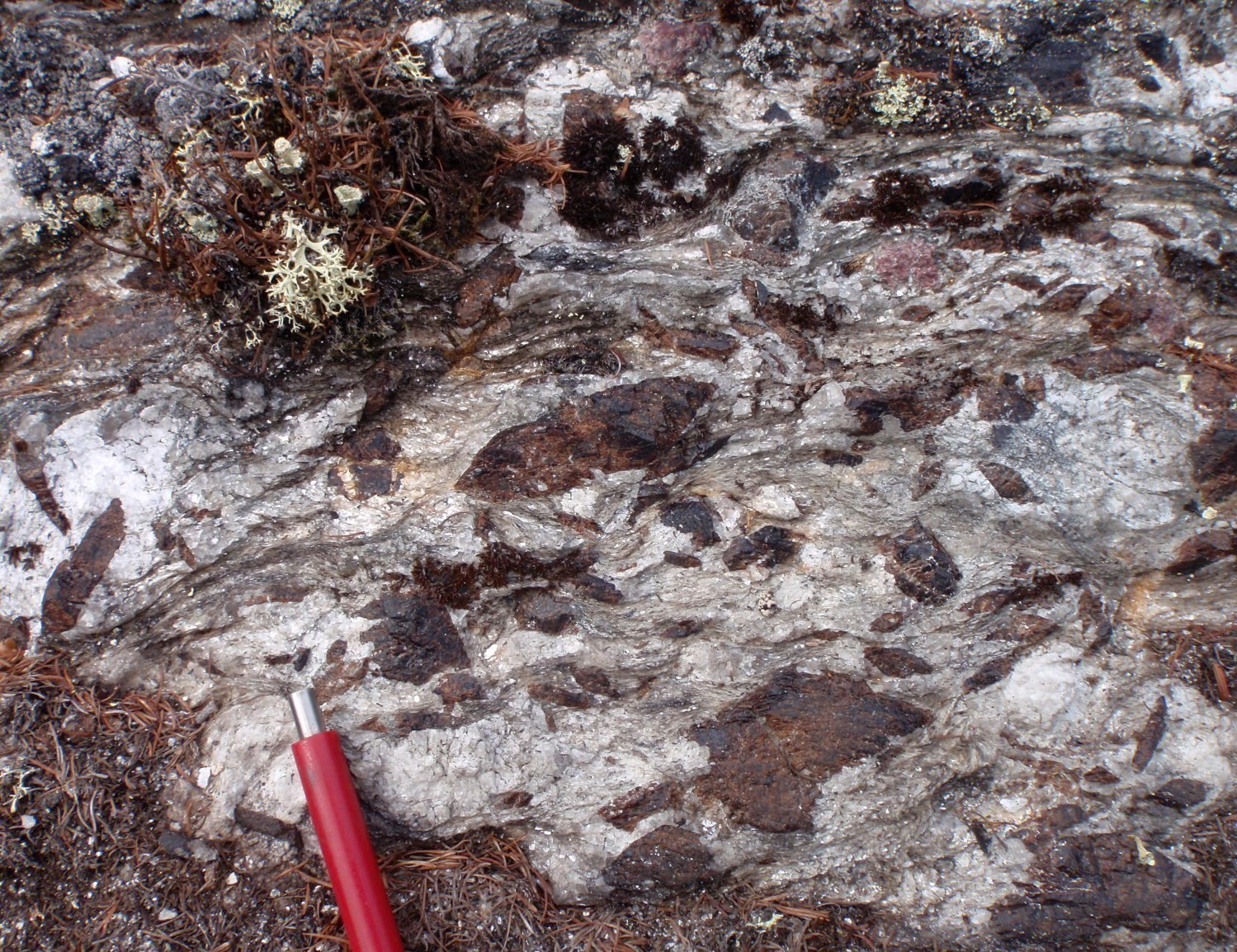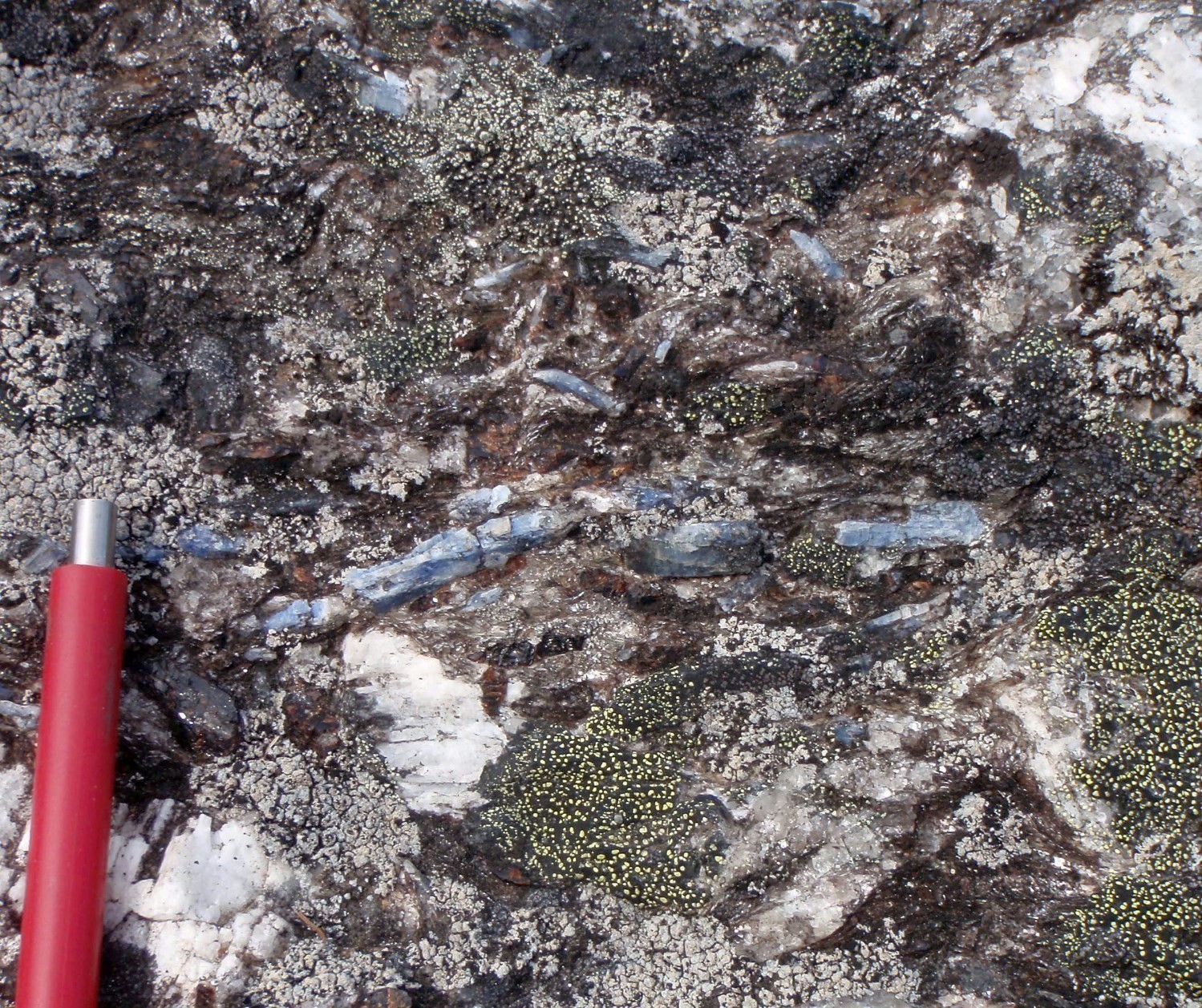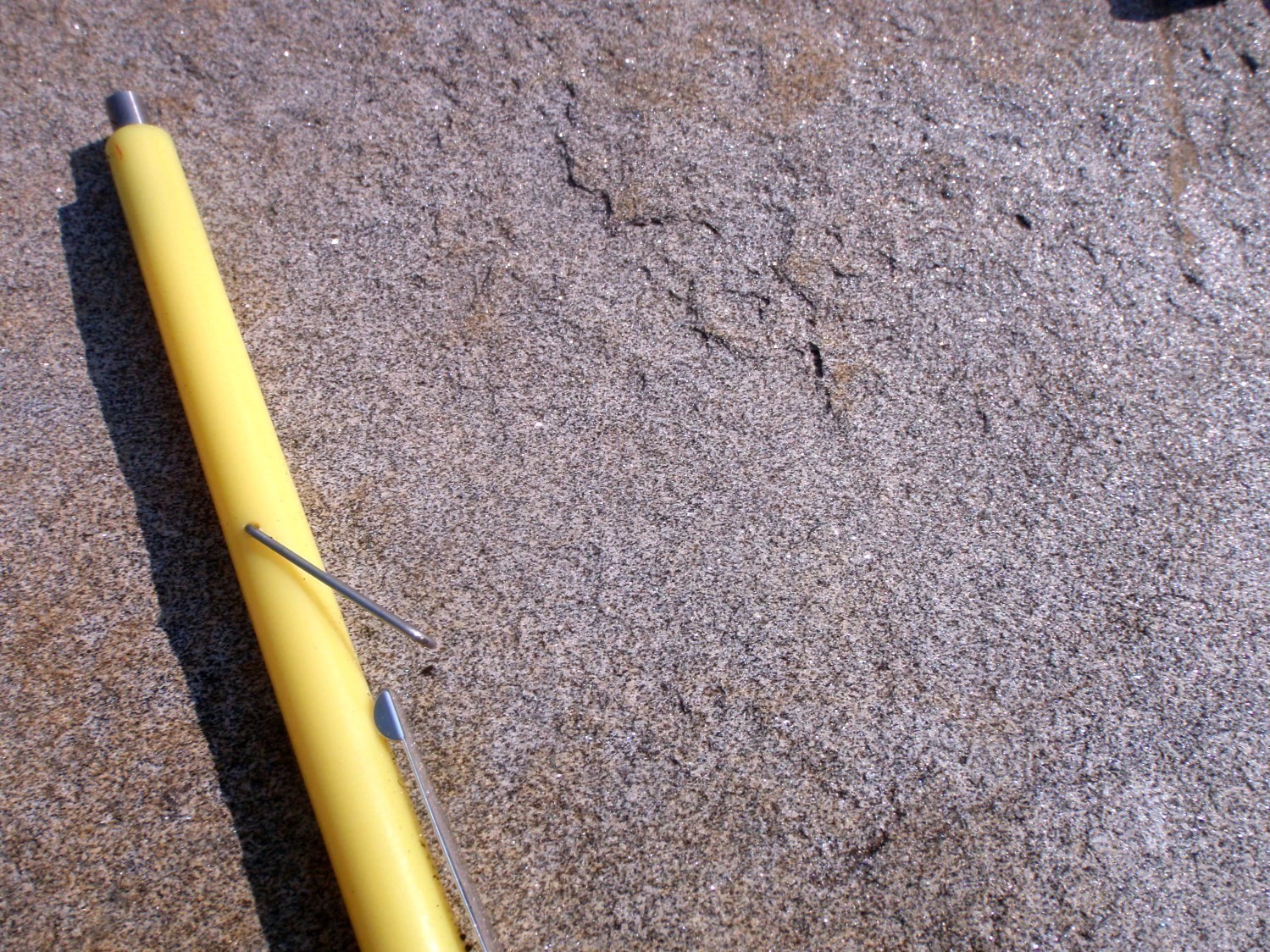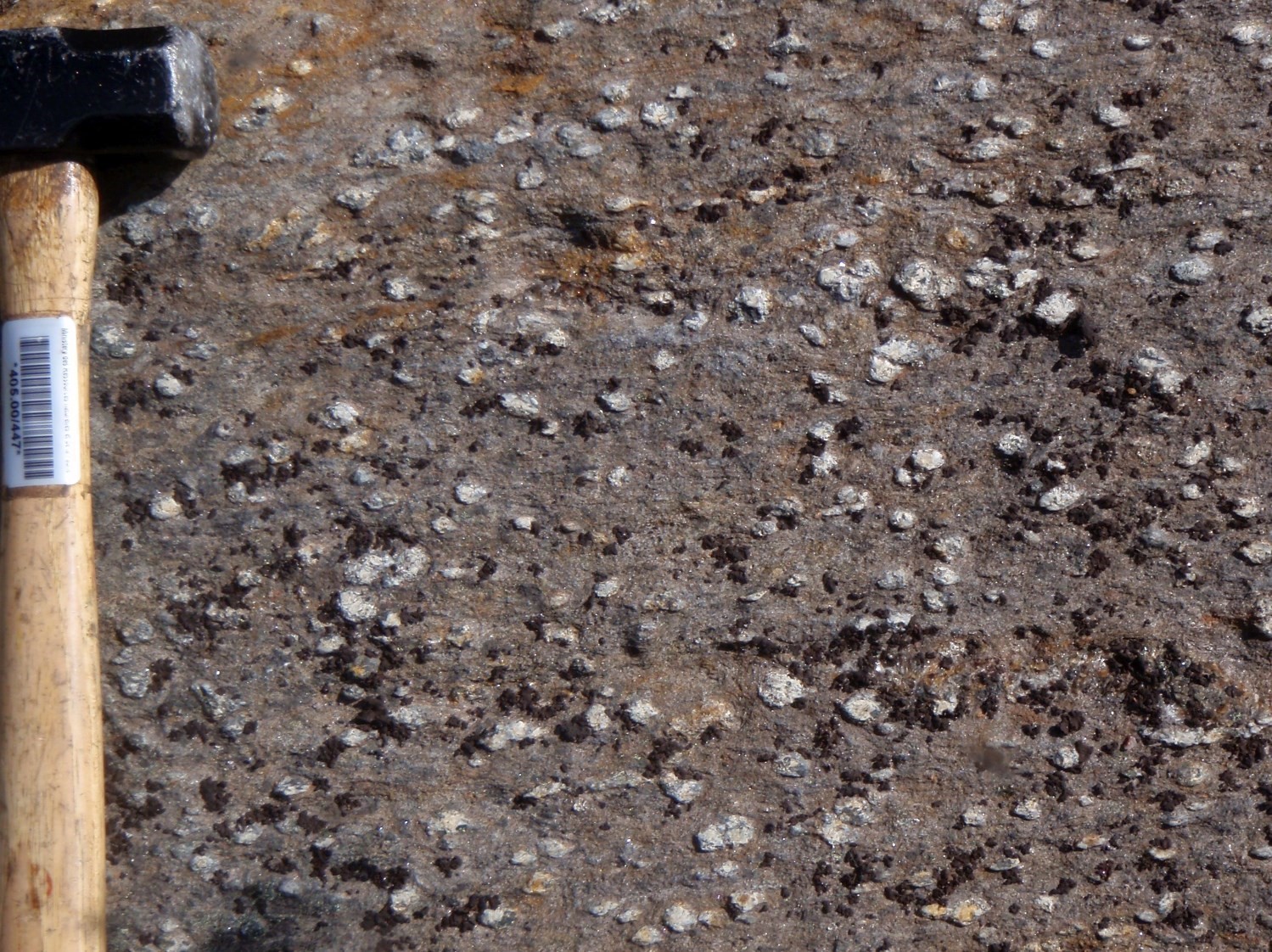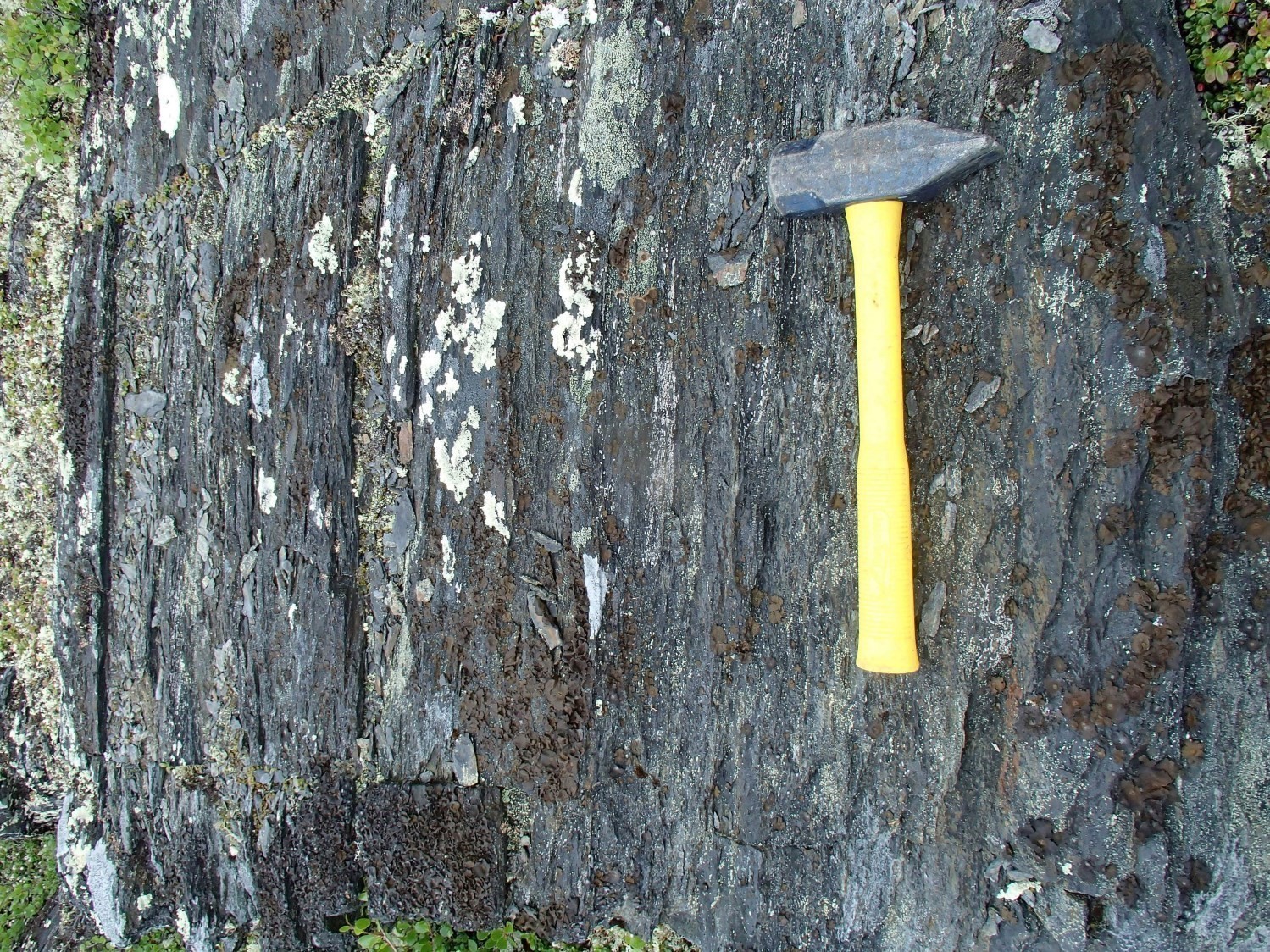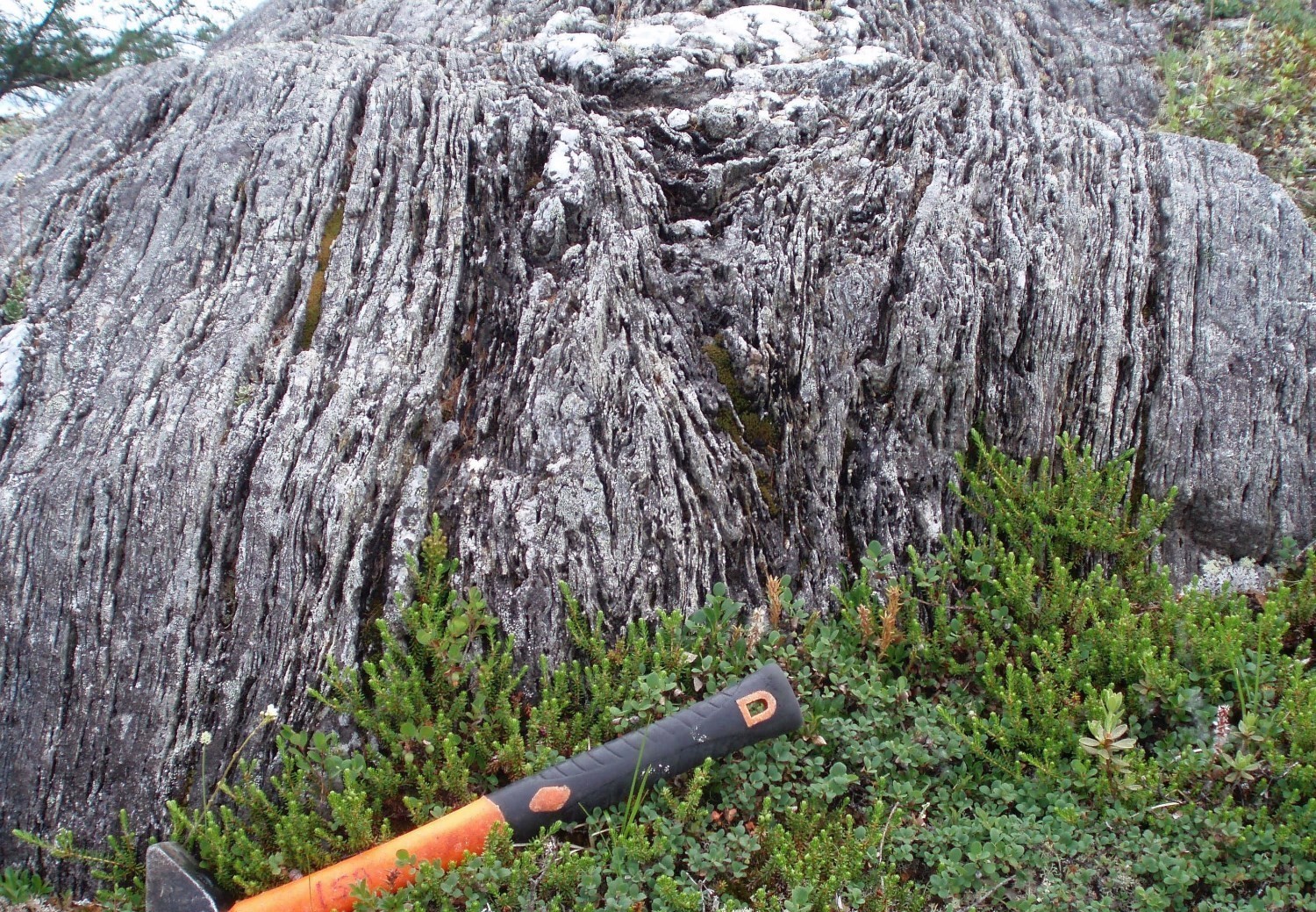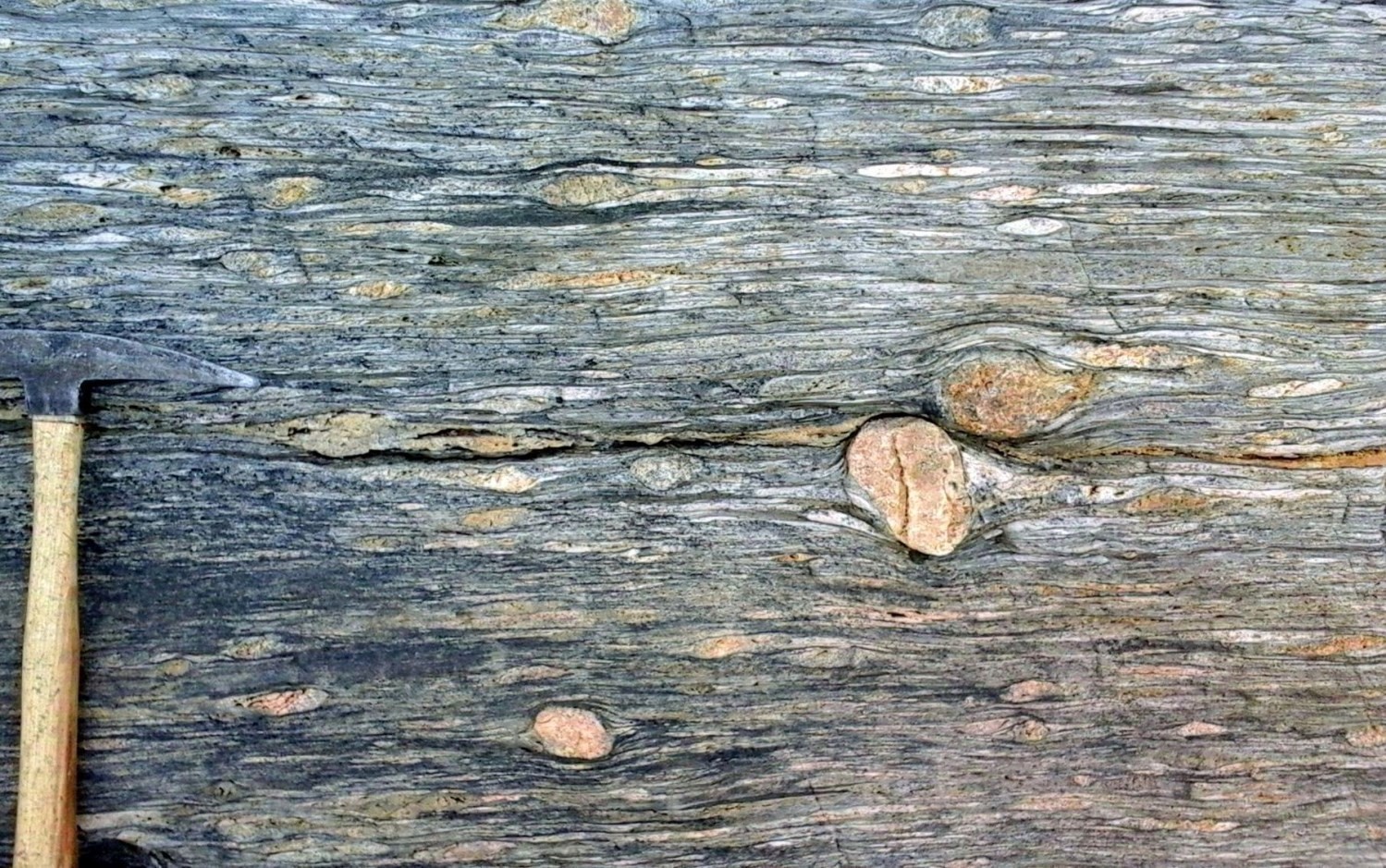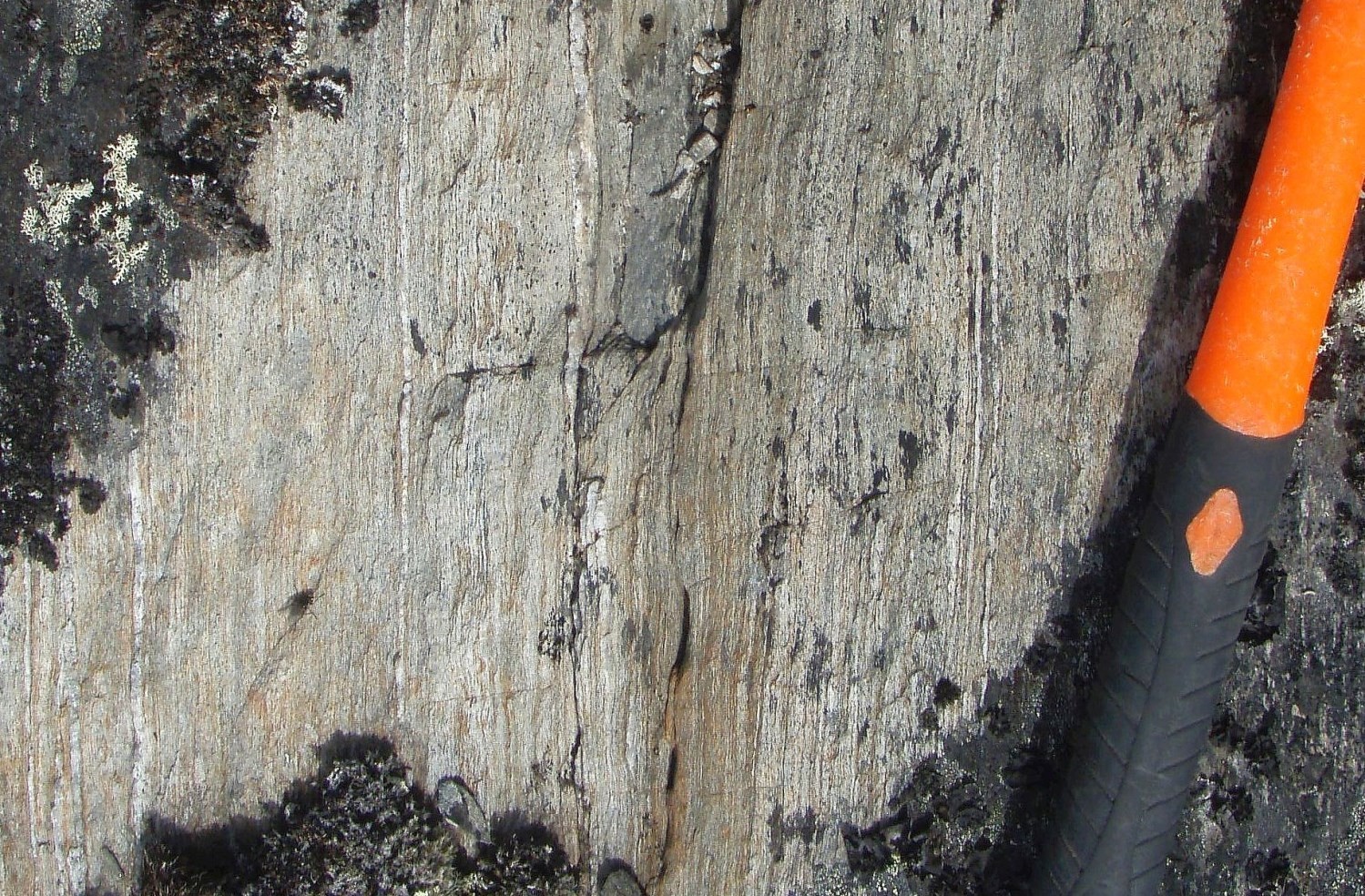
DISCLAIMER: This English version is translated from the original French. In case of any discrepancy, the French version shall prevail.
| Author(s): | Simard et al., 2013 |
| Age: | Paleoproterozoic |
| Stratotype: | None |
| Type area: | Kuujjuaq and Ungava Bay area (NTS sheet 24K) |
| Geological province: | Churchill Province |
| Geological subdivision: | Rachel-Laporte Lithotectonic Domain |
| Lithology: | Metasedimentary rocks |
| Category: | Lithodemic |
| Rank: | Suite |
| Status: | Formal |
| Use: | Active |
- Laporte Supersuite
- Préville Suite
- Klein Suite
- Freneuse Suite
- Secondon Suite
Background
The Freneuse Suite was introduced by Simard et al. (2013) in the Kuujjuaq and Ungava Bay area to group all Laporte Supersuite metasedimentary rocks. The Laporte Supersuite includes Paleoproterozoic volcano-sedimentary rocks of the Rachel-Laporte Lithotectonic Domain, which represents the eastern part of the New Quebec Orogen in the Southeastern Churchill Province (SECP). The Freneuse Suite was continued southward in the Saffray Lake (Lafrance et al., 2014) and Jeannin Lake (Charette et al., 2016) areas.
Metasedimentary rocks now assigned to the Freneuse Suite were first mapped by Sauvé (1957, 1959), Gélinas (1958a, 1958b, 1959), Fahrig (1964), Dimroth (1966), Dressler (1974, 1979), Baragar (1967), Frarey (1967), Penrose (1978), Clark (1978, 1980) and Girard (1995). These observations were incorporated into the SIGÉOM compilation map by Thomas Clark between 2009 and 2016 and used to supplement the description of several units.
In the southern part of the UEGB, a regional compilation by the Ministère in 2003 divided rocks of the Rachel-Laporte Domain into 14 informal units, grouped under the informal term Rachel-Laporte Zone (pPLAP). In the Bonaventure Lake area, Hammouche et al. (2011) recognized units pPLAP1 and pPLAP5. In a synthesis of the SECP, Lafrance and Vanier (2021) abandoned these informal units and reassigned metasedimentary rocks to the different units and subunits of the Freneuse Suite, according to their composition and origin. In the Deborah Lake area (sheet 23P05), Girard (1995) assigned metasedimentary units to the Deborah Formation. This unit has also been abandoned and these metasedimentary rocks are now included in the Freneuse Suite (pPfru1b). Henrique-Pinto et al. (2017, 2019) also extrapolated the use of the terms “Deborah Formation” and “Grand-Rosoy Formation”, used by Girard (1995), to the northern part of the Rachel-Laporte Domain. Further south, since the ages of detrital zircons obtained were only Archean in the Grand Rosoy Suite, Lafrance et al. (2020) revised the boundary between the Rachel-Laporte and Baleine lithotectonic domains to include this unit in the latter. Samples analyzed by Henrique-Pinto et al. (2017, 2019) are thus considered to belong to the Freneuse Suite conglomerate unit (pPfru6) or metawacke and metarenite unit (pPfru1b).
| Revised Units and Subunits | Previous Units and Subunits | Reference(s) |
| pPfru1b | Deborah Formation | Girard, 1995; Henrique-Pinto et al., 2017, 2019 |
| pPfru6 | Grand Rosoy Formation | Henrique-Pinto et al., 2017, 2019 |
| pPfru1a or pPfru1b | pPLAP1 | Hammouche, 2011 |
| pPfru1b or pPfru3b | pPLAP5 (in parts) | Hammouche, 2011 |
| pPfru1f | pPLAP15 (in parts) | Hammouche, 2011 |
Description
The Freneuse Suite consists mainly of paraschist and various metasedimentary rocks (pPfru1), lesser amounts of slightly metamorphosed mudrock (pPfru2), marble and calcosilicate rocks (pPfru3), iron formation (pPfru4), quartzite (pPfru5) and fragmented rocks interpreted as conglomerate or breccia of sedimentary origin (pPfru6).
The Freneuse Suite commonly contains rusty layers mineralized in sulphides (Lafrance and Vanier, 2021).
Freneuse Suite 1 (pPfru1): Bitoite-Muscovite Metasedimentary Rocks
Unit pPfru1 of the Freneuse Suite consists of granoblastic, fine-grained metasedimentary rocks. These rocks usually display millimetric to centimetric banding that may represent primary bedding. This banding is marked by variations in the proportion of micas and grain size (finer in less micaceous bands). Compared to metasedimentary rocks of the Baleine Lithotectonic Domain, those of the Freneuse Suite were not (or very little) affected by migmatization associated with a major regional melting event (Lafrance et al., 2020). Partial melting evidence is still recognized locally, namely in subunit pPfru1f, which is commonly cut by quartz veins subconformable to foliation. These veins are dismembered, boudinaged and folded. Metasedimentary rocks contain biotite and muscovite flakes that define primary foliation. The latter can also be marked by quartz bands and the preferential orientation of plagioclase. It is generally undulating and is affected by a second foliation (crenulation cleavage) marked by coarser mica flakes, indicating the existence of two generations of micas. In places, the foliation is at an angle with compositional banding. Chlorite, altering biotite, and garnet are commonly observed, whereas amphibole is only observed in certain layers.
In thin sections, quartz and plagioclase have highly recrystallized. In some places, 5-25% K-feldspar is also observed as lenticular clusters or poikiloblasts. Garnet forms euhedral to subhedral millimetric poikiloblasts, locally elongated in foliation or deflecting it. These crystals show pressure shadows and generally aligned quartz, plagioclase and mica inclusions, indicating syn-kinematic to late-kinematic growth. Garnet overlaps with biotite and also occurs as small skeletal crystals scattered in the matrix. The main accessory minerals observed in metasedimentary rocks are opaque minerals, apatite and tourmaline with, more locally, sillimanite (fibrolite), carbonate, zircon (as inclusions in biotite and chlorite), epidote, calcite, dark green spinel and sphene.
Unit pPfru1 is divided into seven subunits based on structural, mineralogical or lithological features. These different subunits are generally interstratified and are not individualized at scale 1:250 000.
Freneuse Suite 1a (pPfru1a): Biotite-Muscovite Paraschist
Paraschist of subunit pPfru1a is silver-grey or bluish grey in fresh exposure and beige or light grey in altered patina. It contains a significant amount of muscovite (15-35%) and brown biotite (10-25%) flakes. Locally, schist is characterized by varying amounts of garnet (2-40%), sillimanite, staurolite or kyanite.
If present, sillimanite forms whitish nodules 0.5-2 cm (Simard et al., 2013). Sillimanite also occurs as prismatic crystals aligned with the main foliation or crenulation cleavage. Staurolite forms poikiloblasts containing aligned quartz ± opaque mineral inclusions. Sparser, kyanite typically occurs as porphyroblasts fractured and elongated in foliation. It locally contains quartz inclusions. Chlorite is also observed altering staurolite, as well as at the edge of kyanite crystals.
Freneuse Suite 1b (pPfru1b): Homogeneous Biotite-Muscovite Metawacke and Meta-Arenite
Metasedimentary rocks of subunit pPfru1b are grey in fresh exposure and very light grey in altered surface. The protolith is probably arkosic and lithic wacke. However, the presence of meta-arenite is also common. Micas, less abundant than in paraschist of subunit pPfru1a, consist of brown to reddish brown biotite (10-20%) and muscovite (2-10%) generally concentrated in millimetric laminae. In the Saffray Lake area (Lafrance et al., 2014), rocks are more deformed in the vicinity of the Lac Turcotte Fault and regularly display a mylonitic texture with quartz bands. In the Jeannin Lake area (Charette et al., 2016), 5 km to 10 km north of Nachicapau Lake, outcrops of laminated rocks resembling intermediate tuff were also assigned to subunit pPfru1b. Finally, layers containing lenticular fragments of mafic or felsic rocks that could represent lapilli metatuff or lithic metawacke are observed.
Freneuse Suite 1c (pPfru1c): Biotite-Muscovite-Sillimanite Paraschist and Paragneiss
Paraschist and paragneiss of subunit pPfru1c are similar to rocks of subunits pPfru1a and pPfru1b, except that sillimanite is pervasive. The latter is prismatic or occurs as fibrolite nodules. Fine garnet crystals or porphyroblasts may also be found.
Freneuse Suite 1d (pPfru1d): Biotite-Muscovite-Garnet Paraschist and Paragneiss
Freneuse Suite 1e (pPfru1e): Biotite-Muscovite Paraschist and Quartzitic Paraschist Containing Abundant Amphibolite
Although metasedimentary rocks of the Freneuse Suite are commonly interstratified with amphibolite of the Klein Suite, subunit pPfru1e is characterized by the presence of numerous thin amphibolite layers and sills within the metasedimentary sequence. All observations indicate sharp and well-defined contacts between the two units. It should be noted that the pPfru1e subunit was individualized only by Sauvé (1956; 1957) in the Freneuse Lake area.
Freneuse Suite 1f (pPfru1f): Biotite-Muscovite Paragneiss, Locally Slightly Migmatized
Subunit pPfru1f paragneiss groups granoblastic rocks interpreted by Bilodeau (2018) as being of metasedimentary origin and forming a coherent entity within a tectonic window, south of Baie-aux-Feuilles (sheet 24K06). Rocks are composed of quartz, feldspar, muscovite and biotite. They locally contain garnet porphyroblasts or sillimanite nodules. These rocks differ from subunit pPfru1a paraschist by their complete recrystallization and by a more pronounced metamorphic banding. Generally, quartzofeldspathic bands alternate with mica-rich lepidoblastic bands. The rock may also contain up to 10% hololeucocratic bands composed of feldspar and quartz interpreted as possible leucosomes derived from partial melting. This tectonic window is located within a synclinal structure and may represent a metamorphic dome.
In the southern part of the Rachel-Laporte Domain, two paragneiss klippes containing decimetric to metric layers of metatexite and diatexite have also been described.
Unit pPfru1f is located at the eastern edge of the Rachel-Laporte Domain, and may represent sequences that were more deeply buried during the New-Quebec Orogen (Lafrance and Vanier, 2021). However, it is also important to mention that the metamorphic modelling work of Godet et al. (2020) on a sample previously identified as having undergone partial melting did not confirm the reaching of anatectic conditions.
Freneuse Suite 1g (pPfru1g): Banded Siliceous Orthoclase Paragneiss
Unit pPfru1g corresponds to the « Eastern Gneissic Complex » described by Gold (1962) in the northern part of the Rachel-Laporte Domain. Paragneiss is siliceous, banded, medium grained and grey or pink. It is composed of orthoclase, quartz, biotite and locally garnet. It contains bands and flakes of schistose amphibolite, quartzite, garnet paragneiss and calcosilicate rocks.
Freneuse Suite 2 (pPfru2): Metamudrock and Graphitic Schist
In addition to klippes drawn on the map, unit pPfru2 also forms non-mappable decimetric beds that are interstratified with metasedimentary rocks of unit pPfru1. The rock is aphanitic and dark grey to black, locally bluish. It consists of a very finely recrystallized feldspar-quartz-mica matrix containing coarser crystals of biotite, garnet and opaque minerals, mainly graphite and sulphides. Chlorite, apatite and zircon are accessory phases observed in thin sections.
Freneuse Suite 2a (pPfru2a): Biotite-Rich Paraschist
Metasedimentary rocks of subunit pPfru2a consist of biotite-rich paraschist, dark grey to black in fresh exposure and black and rust in altered surface. They contain millimetric layers of recrystallized quartz and layers of very fine black biotite flakes (20-50%). Garnet porphyroblasts (1-5%) are generally present, but are not diagnostic. Other secondary minerals are chlorite, plagioclase and opaque minerals (mainly pyrite and graphite). Accessory minerals are zircon, rutile and sphene. Muscovite is generally absent or observed only in very small amounts. The nature of protoliths is obliterated by metamorphism and slaty parting. They appear to consist of very fine-grained detrital sedimentary rocks (e.g. mudstone) which may correspond to a more metamorphosed and deformed equivalent of unit pPfru2.
Freneuse Suite 3 (pPfru3): Marble and Calcosilicate Rocks
Unit pPfru3 consists of marble (pPfru3a) and calcosilicate rocks (pPfru3b) which typically occur in discontinuous beds a few hundred metres thick. It also includes marble and calcosilicate rock units previously assigned to unit pPLAP5 (Hammouche et al., 2011). The most important marble and calcosilicate rock sequences are located near large thrust faults, as well as near faulted contacts of the Boulder and Rénia complexes in the Kuujjuaq area (Simard et al., 2013). These lithologies could have facilitated movement along these faults. They also form centimetric to decimetric beds and boudins in metasedimentary rocks of unit pPfru1, as well as in mafic rocks of the Klein Suite.
Freneuse Suite 3a (pPfru3a): Marble, Impure Marble and Dolomitic Marble
Marble of subunit pPfru3a is homogeneous, fine to coarse grained and whitish grey with a light, beige or orange-grey altered surface. It is generally quite pure (locally impure) and composed of completely recrystallized carbonate with serrated edges or as porphyroclasts bordered by more finely recrystallized minerals. The second most important mineral is tremolite, which occurs as millimetric acicular needles and prisms, locally as centimetric to decimetric porphyroblasts or as submillimetric needle sprays. Marble also contains a few quartz lenses and phlogopite layers, possibly representing primary bedding. In some areas, marble contains some diopside or wollastonite (Gélinas, 1958a, 1958b). Accessory minerals are sphene, zircon and apatite. High magnesium contents indicate that marble is composed of a mixture of dolomite and calcite. Plagioclase can account for up to 5% of the rock in places; it is then associated with scapolite.
Freneuse Suite 3b (pPfru3b): Calcosilicate Rocks
On outcrops, calcosilicate rocks form ridges of positive relief compared to marble layers as they contain silicate minerals that are more resistant to erosion. These rocks are heterogeneous, white, grey or green, and display significant variations in composition. They are mostly composed of feldspar, diopside, carbonate, amphibole (tremolite or hornblende) and quartz. The quartzofeldspathic matrix is granoblastic or as anhedral clusters surrounding ferromagnesian minerals. These generally occur as large poikilitic crystals. Diopside is replaced by amphibole. Calcosilicate rocks contain phlogopite (<8%), sphene (<4%) and, in smaller amounts, apatite, zircon, garnet and opaque minerals. Zoisite, scapolite and chlorite, have been observed in places.
Freneuse Suite 4 (pPfru4): Iron Formation
Silicate facies iron formation is the most common and were observed mainly in the Kuujjuaq area (Simard et al., 2013). Unit pPfru4 also includes thin, decimetric to metric layers of grunerite schist, metachert and oxide facies, sulphide facies or carbonate facies iron formation. Sauvé and Bergeron (1965) describe ferriferous units in the Thévenet Lake area (sheet 24K03) as rocks composed of quartz, magnetite, garnet, Fe-amphibole and Fe-carbonate. This latter phase is only abundant in two iron formation klippes located NE of Rachel Lake.
Silicate facies iron formation is generally well banded and consists of alternating light (quartz) and dark (quartz-magnetite or garnet-amphibole ± magnetite) bands. Amphibole occurs as large grains and radial aggregates. Sauvé and Bergeron (1965) describe two types of amphiboles, one resembling hornblende and the other resembling grunerite. The two amphiboles appear to be stable where associated and are occasionally intergrown. Accessory minerals are biotite, chlorite, apatite and tourmaline.
Freneuse Suite 4b (pPfru4b): Sulphide Facies Iron Formation
Sulphide facies iron formation, including layers interstratified with the silicate facies, are characterized by a brecciated texture consisting of 15-35% millimetric to centimetric subrounded to subangular fragments of quartzofeldspathic rocks, forming a Durchbewegung texture, in a very fine-grained and highly magnetic dark matrix. Fragments are mainly composed of granoblastic quartz and plagioclase, whereas the matrix is mainly composed of pyrrhotite with lower amounts of graphite and pyrite. The latter occurs as subhedral crystals (1-4 mm).
Freneuse Suite 4c (pPfru4c): Graphite Metachert
Graphitic metachert is black, very fine grained and displaying millimetric bedding. It is composed of 95% quartz. Pyritic chert, characterized by a diffuse rusty alteration, is locally associated with it.
Freneuse Suite 5 (pPfru5): Quartzite
Quartzite is a finely recrystallized holohyaline rock, whitish, greenish or pinkish, which contains some muscovite and chlorite. It displays millimetric to centimetric bedding marked by muscovite laminae or small hematitized beds. It is cut by 2-10% millimetre to decimetre-wide quartz veins, commonly boudinaged. Some impure quartzite beds contain millimetric to decimetric biotite-muscovite schist beds. In addition to klippes of unit pPfru5 drawn on the map, small quartzite layers were observed within other units of the Freneuse Suite as well as within amphibolites of the Klein Suite.
Freneuse Suite 6 (pPfru6): Quartzofeldspathic Pebble and Fragment Metaconglomerate or Breccia
Unit pPfru6 consists of two hectometre-wide klippes located between the Boulder and Rénia gneissic complexes in the Kuujjuaq area (Simard et al., 2013). Gélinas (1958a) describes this unit as conglomerate or breccia with quartz and feldspar pebbles and fragments in a matrix rich in amphibole and epidote. The rock is highly deformed and contains very stretched fragments 5 cm to 30 cm long by 1 cm to 8 cm wide.
In the northern part of the domain, kilometre-scale klippes were also mapped by Bilodeau (2018) in the Ballantyne Lake and Feuilles Passage areas (sheets 24K11 and 24K14). Conglomerate is predominantly polymictic with non-joint pebbles and cobbles in a quartz-mica- (muscovite-biotite ± chlorite) rich matrix. Pebbles are 5 mm to 10 cm in size and their composition is dominated by granitoids (70%) and quartz (<30%). These may also include paraschist, paragneiss, quartzite and oxide iron formation (hematite). Granitoids include granite and leucocratic quartz-rich granodiorite, as well as mesocratic to leucocratic monzogranite (Henrique-Pinto et al., 2019). In this area, conglomerate is also highly deformed, even mylonitic. Clasts are commonly flattened, stretched and locally boudinaged, to the point of merging with deformed quartzofeldspathic bands. Clasts indicate the presence of a shear zone with apparent dextral movement.
Thickness and distribution
The Freneuse Suite is the main unit of the Rachel-Laporte Lithotectonic Domain. It covers an area of ~10 000 km2 and is generally 25 km to 40 km wide. It is oriented NW-SE. This unit thins out in the northern of the SECP (~3 km), as well as in the vicinity of the Archean Rénia, Highfall and Wheeler complexes. Subunits pPfru1a and pPfru1b are the main units of the Freneuse Suite, covering almost 9149 km2. Subunit pPfru1b dominates in the southern and central parts of the Rachel-Laporte Domain, whereas subunit pPfru1a is dominant in the northern part. The latter is mainly observed in the Kuujjuaq area (Simard et al., 2013) and northern Saffray Lake area (Lafrance et al., 2014), where it forms a metasedimentary sequence ~12 km wide by 170 km long. Another large sequence 9~10 km wide by 90 km long) was recognized farther south in the Jeannin Lake area (Charette et al., 2016). Smaller strips were also observed between the two sequences. Subunit pPfru1b forms a sequence >250 km long by 30 km wide, on both sides fo the Wheeler Complex, along which it thins out, like the rest of the Freneuse Suite.
Subunit pPfru1c was observed in the Kuujjuaq area (Simard et al., 2013) and the northern Saffray Lake area (Lafrance et al., 2014). It is located primarily between the Lac Olmstead and Lac Turcotte faults, where it forms a strip ~45 km long by 500 m to 3 km wide. Subunits pPfru1d, pPfrue and pPfrug form a few hectometric to kilometric strips in in the northern part of the Rachel-Laporte Domain. Finally, subunit pPfru1f was observed at the eastern edge of the lithotectonic domain, both in the north and south.
Unit pPfru2 is mostly in contact with units of the Labrador Trough, where it forms strips several tens of kilometres long and a few kilometres wide. Units pPfru4 and pPfru5 are generally observed as hectometric layers continuous over a few kilometres. However, larger quartzite sequences (pPfru5) are visible in the southern portion of the Jeannin Lake area (40 km by 3 km), near the SW edge of the Rénia Complex (10 km by 3 km), and immediately south of Horseshoe Lake (8 km by 1.5 km). Finally, unit pPfru6 consists of two close klippes, 5 km to 10 km long and <500 m wide, located between the Rénia and Boulder complexes, in the Thévenet Lake area (Gélinas, 1958a), as well as three klippes 1 km to 3 km wide and 10 km to 18 km long, in the northern part of the domain (Bilodeau, 2018).
Dating
Detrital zircons from the Freneuse Suite indicate a wide range of ages, between 3226 Ma and 1831 Ma (Godet et al., 2020). The depositional age is circumscribed between 1834 Ma (age of the youngest detrital zircons) and 1804 Ma (age of garnet growth). However, the distribution pattern of detrital zircon age populations across samples indicates an evolution of the depositional environment through time (Henrique-Pinto et al., 2017; Godet et al., 2020). Outcrops 2016-AG-2064, 2015-RP-2052 and 2015-MB-4020 have detrital zircon ages with weak main modes at ~2500 Ma and ~2245 Ma, suggesting a source as far back as the Mistinibi-Raude Domain. They also include older modes between 2700 Ma and 2500 Ma and younger modes at ~1840 Ma, so that units of the George and Baleine domains probably acted as a source (Godet et al., 2020). Sample 2015-IL-3047, with a main mode at ~2.7 Ga, suggests a more proximal source, the Baleine Domain. Finally, in samples taken on outcrops 2015-RP-2309 and 2015-RP-2319, more than three quarters of detrital zircons are between 1.85 Ga and 1.82 Ga in age, consistent with magmatic activity associated with the New Quebec Orogen that led, among other things, to the emplacement of the De Pas Supersuite (located mainly in the George Domain).
Henrique-Pinto et al. (2017, 2019) suggest two sedimentation cycles in the Rachel-Laporte Domain. The first cycle is related to the deposition of conglomerate and arkose in a continental forearc basin context. The second cycle is associated with the deposition of feldspathic wacke in a continental foreland basin setting. Based on geochronology and metamorphic modelling, Godet et al. (2020) interpret that the Baleine Domain overthrusted the Rachel-Laporte Domain along the Lac Turcotte Fault between 1830 Ma and 1800 Ma, causing burial and amphibolite facies metamorphism of the latter at ~1793 Ma (Machado et al., 1989).
| Unit | Sample Number | Isotopic System | Mineral | Maximum Age of Deposition (Ma) | (+) | (-) | Detrital Age (Ma) | Metamorphic Age (Ma) | (+) | (-) | Reference(s) |
| pPfru1a | 2015-IL-3047A | U-Pb | Zircon | 1837 | 12 | 12 | 2850-2500 | 1837 (detrital overgrowth) | 12 | 12 | Godet et al., 2020 |
| Monazite | 1796 | 4 | 4 | ||||||||
| pPfru1a | 2016-AB-2064A | U-Pb | Zircon | 1834 | 4 | 4 | 3226-1831 | 1834 (detrital overgrowth) | 4 | 4 | Godet et al., 2020 |
| Lu-Hf | Grenat | 1804.4 | 7.5 | 7.5 | |||||||
| pPfru1f | 2015-MB-4020A | U-Pb | Zircon | 1890 |
2800-2050 |
Henrique-Pinto et al., 2017 | |||||
| pPfru6 | 2015-RP-2309A | U-Pb | Zircon | 1834 | 2.4 | 2.4 |
3600-1800 |
Henrique-Pinto et al., 2017 | |||
| pPfru1b | 2015-RP-2319A | U-Pb | Zircon | 1840 |
2800-1800 |
Henrique-Pinto et al., 2017 | |||||
| pPfru1b | 2015-RP-2052A | U-Pb | Zircon | 1900 |
3200-1600 |
Henrique-Pinto et al., 2017 |
Stratigraphic Relationship(s)
Rocks of the Freneuse Suite are commonly interstratified with amphibolites and mafic and ultramafic intrusive rocks of the Klein Suite. They also are in fault contact with various Archean or Proterozoic complexes (tectonic slices) of the Rachel-Laporte Domain or Labrador Trough, namely the Boulder, Rénia, Highfall, Boullé, Wheeler and Giton complexes. (Simard et al., 2013; Lafrance et al., 2014; Charette et al., 2016). The various units of the Freneuse Suite are also locally intruded by granite and pegmatitic granite dykes or sills of the Mercier Suite.
Several authors have proposed that metasedimentary rocks of the Freneuse Suite largely represent more metamorphosed equivalents of metasedimentary rocks of the Kaniapiskau Supergroup located in the Labrador Trough, just to the west (Harrison, 1952; Gélinas, 1958a, b; Sauvé and Bergeron, 1965; Simard et al., 2013). However, significant differences between the detrital zircon populations of these two lithotectonic domains indicate different sources (Henrique-Pinto et al., 2017), confirming the hypothesis of Charette et al. (2016) who questioned this equivalence based on the apparent thickness and composition of metasedimentary rocks of the two domains. The age distribution of detrital zircons found in the Freneuse Suite ranges from 3226 Ma to 1830 Ma (Herrique-Pinto et al., 2017; Godet et al., 2020) and includes Paleoproterozoic and Archean population peaks. The latter are interpreted to indicate provenance from different lithotectonic domains of the SECP, namely the George, Baleine and Mistinibi-Raude domains (Henrique-Pinto et al., 2017, 2019). The source of the sediments forming rocks of the Kaniapiscau Supergroup would be the Superior Province, since all detrital zircons are Archean (Henrique-Pinto et al., 2017, 2019).
Although similar maximum ages of deposition have been obtained within samples of the Freneuse Suite in both the northern and central parts of the Rachel-Laporte Domain (<1834 Ma; Henrique-Pinto et al., 2017; Godet et al., 2020), the ~1883.5 Ma age obtained in a Klein Suite gabbro indicates that metasedimentary rocks of the Freneuse Suite also comprise an older sequence that allowed the emplacement of mafic sills older than 1834 Ma. It is also possible that some of the rocks included in the Rachel-Laporte Domain were derived from the Labrador Trough and were tectonically imbricated within the domain (Lafrance and Vanier, 2021).
Paleontology
Does not apply.
Références
Publications Available Through SIGÉOM Examine
BILODEAU, C., 2018. Géologie de la partie nord du Domaine de Rachel-Laporte, région de Kuujjuaq, Nunavik, Québec, Canada. MERN; CG-2018-07
CHARETTE, B., LAFRANCE, I., MATHIEU, G., 2016. Géologie de la région du lac Jeannin, Québec, Canada. MERN; BG 2015-01, 1 plan.
CLARK, T., 1978. REGION DU LAC HERODIER ( NOUVEAU-QUEBEC) – RAPPORT PRELIMINAIRE. MRN; DPV 568, 48 pages, 2 plans.
CLARK, T., 1980. REGION DE LA RIVIERE KOKSOAK (NOUVEAU-QUEBEC) – RAPPORT PRELIMINAIRE. MRN; DPV 781, 24 pages, 1 plan.
CLARK, T., WARES, R., 2004. SYNTHESE LITHOTECTONIQUE ET METALLOGENIQUE DE L’OROGENE DU NOUVEAU-QUEBEC (FOSSE DU LABRADOR). MRNFP; MM 2004-01, 182 pages, 1 plan.
DIMROTH, E., 1966. GEOLOGIE DE LA REGION DU LAC DUNPHY, TERRITOIRE DU NOUVEAU-QUEBEC. MRN; RP 557, 24 pages, 1 plan.
GELINAS, L., 1958. RAPPORT PRELIMINAIRE SUR LA REGION DU LAC GABRIEL (PARTIE OUEST), NOUVEAU-QUEBEC. MRN; RP 373, 13 pages, 1 plan.
GELINAS, L., 1958. RAPPORT PRELIMINAIRE SUR LA REGION DU LAC THEVENET (MOITIE EST), NOUVEAU-QUEBEC. MRN; RP 363, 11 pages, 1 plan.
GELINAS, L., 1959. REGION DU LAC GABRIEL (PARTIE EST) ET LA REGION DE FORT CHIMO (PARTIE OUEST), NOUVEAU-QUEBEC. MRN; RP 407, 13 pages, 1 plan.
GIRARD, R., 1995. GEOLOGIE DE LA REGION DU LAC DEBORAH, TERRITOIRE-DU-NOUVEAU-QUEBEC. MRN; MB 95-20, 186 pages, 3 plans.
GOLD, D P., 1962. RAPPORT PRELIMINAIRE SUR LA REGION DE LA BAIE HOPES ADVANCE, NOUVEAU-QUEBEC. MRN; RP 442, 13 pages, 1 plan.
HAMMOUCHE, H., LEGOUIX, C., GOUTIER, J., DION, C., PETRELLA, L., 2011. GEOLOGIE DE LA REGION DU LAC BONAVENTURE. MRNF; RG 2011-03, 37 pages, 1 plan.
LAFRANCE, I., CHARETTE, B., VANIER, M-A., 2018. Sud-est de la Province de Churchill, Nunavik, Québec, Canada: synthèse de la géologie. MERN; BG 2018-12
LAFRANCE, I., SIMARD, M., BANDYAYERA, D., 2014. GEOLOGIE DE LA REGION DU LAC SAFFRAY (SNRC 24F, 24G). MRN; RG 2014-02, 51 pages, 1 plan.
LAFRANCE, I., VANIER, M-A., CHARETTE, B., 2020. Domaine lithotectonique de Baleine, sud-est de la Province de Churchill, Québec, Canada: synthèse de la géologie. MERN; BG 2020-07, 4 plans.
PENROSE, B., 1978. GEOLOGIE DE LA REGION DU LAC HORSESHOE (NOUVEAU-QUEBEC). MRN; DPV 573, 39 pages, 1 plan.
SAUVE, P., 1956. RAPPORT PRELIMINAIRE SUR LA REGION DU LAC DE FRENEUSE (MOITIE OUEST), NOUVEAU-QUEBEC. MRN; RP 332, 10 pages, 1 plan.
SAUVE, P., 1957. RAPPORT PRELIMINAIRE SUR LA REGION DU LAC DE FRENEUSE (MOITIE EST), NOUVEAU-QUEBEC. MRN; RP 358, 10 pages, 1 plan.
SAUVE, P., 1959. RAPPORT PRELIMINAIRE SUR LA REGION DE LA BAIE AUX FEUILLES, NOUVEAU-QUEBEC. MRN; RP 399, 15 pages, 1 plan.
SAUVE, P., BERGERON, R., 1965. REGION DES LACS GERIDO ET THEVENET, NOUVEAU-QUEBEC. MRN; RG 104, 141 pages, 3 plans.
SAUVE, P., BERGERON, R., 1965. GERIDO LAKE – THEVENET LAKE AREA, NEW QUEBEC. MRN; RG 104(A), 131 pages, 3 plans.
SIMARD, M., LAFRANCE, I., HAMMOUCHE, H., LEGOUIX, C., 2013. GEOLOGIE DE LA REGION DE KUUJJUAQ ET DE LA BAIE D’UNGAVA (SNRC 24J, 24K). MRN; RG 2013-04, 62 pages, 1 plan.
WARES, R., GOUTIER, J., 1990. SYNTHESE METALLOGENIQUE DES INDICES DE SULFURES AU NORD DU 57e PARALLELE – FOSSE DU LABRADOR – RAPPORT INTERIMAIRE – ETAPE III. IREM-MERI; MB 90-25, 104 pages, 2 plans.
Other Publications
BARAGAR, W.R.A., 1967. Wakuach Lake map-area, Quebec-Labrador (23 O). Geological Survey of Canada; Memoir 344, 174 pages. doi.org/10.4095/123960
FAHRIG, W. F., 1965. Lac Hérodier, Québec. Commission géologique du Canada; carte 1146A (carte annotée). doi.org/10.4095/107520
FRAREY, M.J., 1967. Willbob Lake and Thompson Lake map-areas, Quebec and Newfoundland (23 0/1 and 23 O/8). Geological Survey of Canada; Memoir 348, 73 pages. doi.org/10.4095/123896
GODET, A., GUILMETTE, C., LABROUSSE, L., DAVIS, D.W., VANIER, M.-A., LAFRANCE, I., CHARETTE, B., 2020. Contrasting P-T-t paths reveal a metamorphic discontinuity in the New Quebec Orogen: insights into Paleoproterozoic orogenic processes. Precambrian Research, volume 342, page 105675. doi.org/10.1016/j.precamres.2020.105675
HARRISON, J.M., 1952. The Quebec-Labrador iron belt, Quebec and Newfoundland. Geological Survey of Canada; Paper 52-20, 21 pages. doi.org/10.4095/123923
HENRIQUE-PINTO, R., GUILMETTE, C., BILODEAU, C., McNICOLL, V., 2017. Evidence for transition from a continental forearc to a collisional pro-foreland basin in the eastern Trans-Hudson Orogen: Detrital zircon provenance analysis in the Labrador Trough, Canada. Precambrian Research, volume 296, pages 181-194. doi.org/10.1016/j.precamres.2017.04.035
HENRIQUE-PINTO, R., GUILMETTE, C., BILODEAU, C., STEVENSON, R., CARVALHO, B.B., 2019. Petrography, geochemistry, and Nd isotope systematics of metaconglomerates and matrix-rich metasedimentary rocks: implications for the provenance and tectonic setting of the Labrador Trough, Canada. Canadian Journal of Earth Sciences, volume 56, pages 672-687. doi.org/10.1139/cjes-2018-0187
Suggested Citation
Ministère de l’Énergie et des Ressources naturelles (MERN). Freneuse Suite. Quebec Stratigraphic Lexicon. https://gq.mines.gouv.qc.ca/lexique-stratigraphique/province-de-churchill/suite-de-freneuse_en [accessed on Day Month Year].
Contributors
|
First publication |
Isabelle Lafrance, P. Geo., M.Sc. isabelle.lafrance@mern.gouv.qc.ca (redaction) Mona Baker, P. Geo., M.Sc. (coordination); Thomas Clark, P. Geo., Ph.D. and James Moorhead, P. Geo., M.Sc. (critical review); Pierre Lacoste, P. Geo., M.Sc. (editing); Céline Dupuis, P. Geo., Ph.D. (English version); André Tremblay (HTML editing). |


